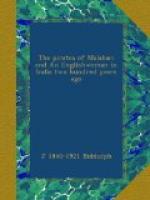His short experience of six months under the Company had completely disgusted Alexander Hamilton. Immediately on his return to Bombay he resigned his post as Commander-in-Chief of their ships-of-war, and resumed business as a private trader. His relations with the military officers during the expedition appear to have been satisfactory, but against Taylor, the head of the Carwar factory, he formulated a series of charges, accusing him of having been the cause of the trouble with the Rajah, through his indiscretion and bad faith. Taylor retaliated by accusing Hamilton of not having taken proper measures to relieve the factory. The Council investigated the charges, and contented themselves with cautioning Taylor to behave better in future.
The unfortunate topasses, who had had their noses cut off, were formed into a company of marines, and had their pay augmented to Rs.5 a month.[3] In this odd way the Bombay Marine Battalion appears to have had its origin.
We get some idea of the Sunda Rajahs of the period in a letter from Carwar, dated the 20th January, 1698.
“He” (the Sunda Rajah) “is so excessive craving after money, that he is about sacrificing twelve men and twelve women with child, to get two pots of treasure which one of his magicians tells him lies buried near his palace.”
While these events were taking place at Carwar, Boone found himself involved in trouble with Angria. For some time after the treaty made by Aislabie, Angria had respected Bombay trading ships, but of late he had begun to show his teeth again. In the beginning of 1716 he had made prize of a Company’s boat in sight of the harbour, and of another belonging to a private merchant. Four private ships from Mahim, valued at 30,000 xeraphims, were also captured by him, and his ships trading to Bombay refused to pay harbour dues. While Hamilton was engaged at Carwar, Angria’s fleet attacked and took the Success, East Indiaman, on its way from Surat. With an impoverished exchequer, a force weakened and disorganized by the Carwar adventure, and no ammunition in his magazine, Boone found himself in no condition to take active measures for the present.
In the vain hope of bringing Angria to reason, a letter of expostulation was written, which met with a hostile response, quickly followed by the capture of the Otter, a Bengal ship. A second letter of defiance was received, so, on the 7th May, in spite of inadequate resources, the Council resolved on striking a blow. An expedition against Gheriah was determined on, and twenty gallivats were sent down, manned with sepoys, to retake, if possible, the captured vessels, “if they were attacked, to repel force by force, and if possible plunder his country.” The official record of the expedition is as follows:—
4th June.—Two
gallivats returned having plundered a town in Angria’s
country, and brought away
sixteen prisoners.




